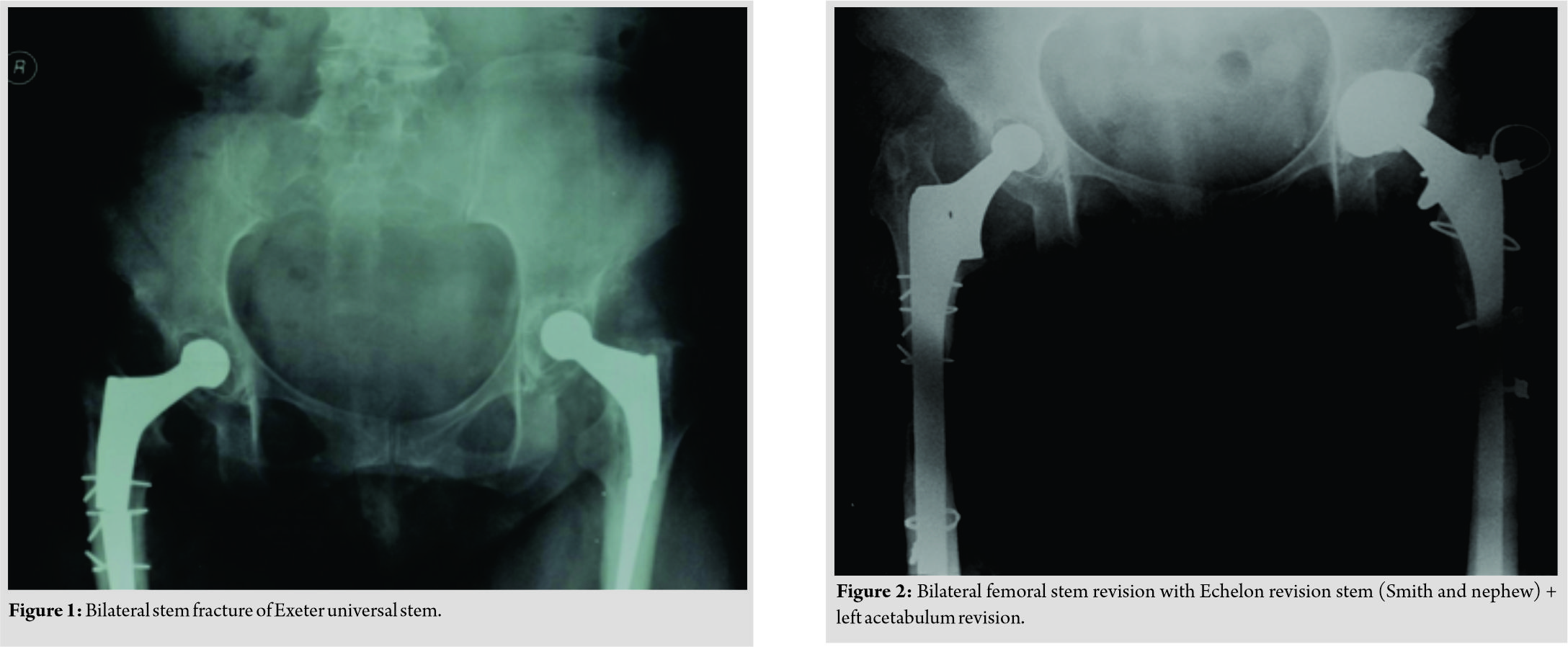[box type=”bio”] Learning Point of the Article: [/box]
To avoid femoral stem fracture, preoperative planning and choosing appropriate stem size is crucial
Case Report | Volume 9 | Issue 4 | JOCR July-August 2019 | Page 48-50 | NazmiBulent Alp, Nejat Guney. DOI: 10.13107/jocr.2019.v09i04.1474
Authors: NazmiBulent Alp[1], Nejat Guney[2]
[1]Department of Orthopedics and Traumatology, Faculty of Medical, Bursa Uludag University, Bursa, Turkey,
[2]Department of Orthopaedics and Traumatology, Nisantasi Orthopedics Center, Private Practice, Sisli-Istanbul, Turkey.
Address of Correspondence:
Dr. NazmiBulent Alp,
29 EkimMah 413.sok. No. 5 D Blok D: 29, Ozluce-Nilüfer/Bursa-Turkey.
E-mail: nazmibulentalp@hotmail.com
Abstract
Introduction: Total hip arthroplasty(THA) in dysplastic hips involves technical difficulties due to impaired anatomy. Specially designed implants are needed for dysplastic hips. Usage of these implants with appropriate material and design features reduces the pain in this group of patients and increases the standard of life. Improper implant selection causes various complications. The presented case is about a 62-year-old female patient who was operated bilaterally for coxarthrosis secondary to developmental hip dysplasia. She had minimal complaints during her last outpatient follow-up. Radiographs revealed a fracture of the simultaneous bilateral femoral stem.
Case Report: Seventeen years ago, a 45-year-old lady was admitted to our hospital due to coxarthrosis secondary to developmental hip dysplasia. In six months interval, she underwent bilateral THA with Exeter™ Universal Hip system.She had re-operated on her 3rd year because of right femoral stem fracture.Since then, she has beenexamined at the outpatient clinic regularly on1-year-based intervals. There was no trauma or obvious activity experienced. Radiographs of the pelvis and bilateral femur were obtained, andit was demonstrated that both femoral stems were broken. Both fractured stems were removed by extended femoral osteotomy via a lateral approach.Intraoperative examination revealedthat the right acetabular component was well-fixed, but there was a loosening of the left acetabularcomponent. The acetabular revision was performed to the left side. Echelon cementless revision hip system (Smith and Nephew) was used for the right and left sides. The patient was stood–up on the first post-operative day and weight-bearing was permitted as much as tolerated. At the end of 6 weeks, full weight bearing was permitted. She was returned to her routine daily life activities after 4 months.
Conclusion: After the acquisition of Howmedica by Stryker in 1998, the taper in the Exeter stem was modified, and a new Exeter V40 stem concept was introduced in 2001, but still in literature, we could comeacross stem fracture cases. We may not eliminate all prosthetic fractures, but we may reduce them as low as possible by doing appropriate cementing, placing the stem in proper alignment and for us, the most important one is pre-operative templating. Spending some time in front of X-rays and choosing the appropriate size of a stem is the most helpful step while eliminating the prosthetic fractures.
Keywords: Total hip arthroplasty, developmental hip dysplasia, Exeter, stem fracture.
Introduction
In 1932, Guillaume Dupuytren defined hip dislocation as original or congenital hip dislocation, which was associated with birth. The first open reduction of congenital hip dislocation wasdescribed by Alfonso Poggi in Bologna in 1880. Many years later, Sir John Charnley introduced cemented total hip arthroplasty(THA) [1]. It became a milestone in the treatment of coxarthrosis. The goal of THA is to reduce pain and increase the function of the patient. Combining accurate indication with a successful surgical technique is the most critical point in achieving good and perfect results in THA applications. THA in dysplastic hips involves technical difficulties due to impaired anatomy. Specially designed implants are needed for dysplastic hips. Usage of these implants with appropriate material and design features reduces the pain in this group of patients and increases the standard of life. Improper implant selection causes various complications.Duringapplication of the THA, the initial stability of the components is essential to obtain successful results. There are cemented, and uncementedimplants are available in the market. The presented case is about a 62-year-old female patient who was operated bilaterally forcoxarthrosis secondary to developmental hip dysplasia. She had minimal complaints during her last outpatient follow-up. Radiographs revealed a fracture of the simultaneous bilateral femoral stem. We aim to explain the possible reasons for bilateral Exeter™ femoral stem fracture.
Case Report
Seventeenyears ago, a45-year-old lady was admitted to our hospital due to coxarthrosis secondary to developmental hip dysplasia. In six months interval, she underwent bilateral THA with Exeter™ Universal Hip system. She had re-operated on her 3rd year because of right femoral stem fracture.Since then, she has beenexamined at the outpatient clinic regularly on1-year-based intervals. Onher last follow-up, the physical examination revealed minimal pain on her right thigh and nothing more. The patient was 1.62 m tall and weighed 84 kg, with abody mass index (BMI) of 31.25kg/m2 (obese class).There was no difference between the range of motion of bilateral knees and hips when compared withprevious records. The patient’s gait was observed adequately, and nothing significant was detected. There was no trauma or obvious activity experienced. Radiographs of the pelvis and bilateral femur were obtained,and it was demonstrated that both femoral stems were broken (Fig. 1). It was also revealed that radiolucent lines had seen both femoral stems and left acetabulum.The patient was informed of the fact that this asymptomatic situation requires revision surgery. With the informed consent of the patient, revision surgery was scheduled. Both thefractured stems were removed by extended femoral osteotomy via a lateral approach.Intraoperative examination revealed that the right acetabular component was well-fixed but there was a loosening of the left acetabularcomponent.Acetabularrevision was performed to the left side. Echelon cementless revision hip system (Smith and Nephew) was used for the right and left sides (Fig. 2). Patient was stood–up on the first post-operative day and weight – bearing was permitted as much as tolerated. . At the end of 6 weeks, full weight bearing was permitted. She returned to her routine daily life activities after 4 months. The preoperative Harris score was 90.25, and the postoperative Harris score was 91.25. After 2-year follow-up, no major or minor complications were reported.
Discussion
The basic body structure of Exeter (Stryker, Newbury,UK) has been cemented, collarless, and double tapered since 1970 [2]. The original stems were made up of ductile and relatively low-fatigue-strength alloy EN58. Those are highly polished double-tapered stemsunk within the cement mantle by 1 or 2 mm which was allowing load transmission by compression at bone-cement interface. This may lead to decreased shear forces at the bone–cement interface. This positive characteristic preserves the cement cover and leads to a low unsuccessful rate [2]. Initially, the stems had a sharp angle on the superolateral aspect of the neck.Of the original series of polished Exeter stems, nearly 2%of fractured femoral stems were found during a mean follow-up of 13 years [2]. Latter becauseofan awkward biomechanical feature of sharp angle manufacturer replacedit by smooth curve angle. In 1975, stem thickness increased slightly,andthe alloy was alteredinto 316L with the introduction of matt-surfaced stems. Røkkum et al. [3] reported 3 of 27 matt-surfaced stem fractures. Onfollow-up,fracture of this alloy was associated with high patient weight and activity levels.In 1984,femoral stems manufactured more powerful and less ductile by using stainless steel alloy (Orthinox; high nitrogen stainless steel)and returned to polishes from matt ones in 1986 [4, 5]. Howmedica introduced universal modular stem in 1988 which we used in our patient. Bolland et al. [6] analyzed fracture of the universal Exeter femoral stem prosthesis (UEFS). Between 1991 and 2008,nearly 80 cases of fracture (neck and stem) had been reported. As far as literature was investigated, our case is the first to reportsimultaneous bilateral fracture of UEFS. According to a report by Bolland et al. [6], some correctable reasons for stem fractures are using undersized stems,varus placements, poor bone cementing, and inadequate impaction bone grafting. The last two may lead to poor proximal medial support often with the presence of a well-fixed distal portion of the stem. It had been shown to cause increased tensile stress in the mid-lateral part of the prosthetic stem. Most of the stem fractures occurred in smaller sizes (35.5–44). 35.5 mm offset stem is the most common fractured implant size among that 80 cases, and this was four times more than any other stem [7]. Design features are also a significant potential etiologyof failure. Historical metallurgical analyses have demonstrated material defects including gas porosity, nonmetallic inclusion, and interdendritic shrinkage which may contribute to fracture etiology. Active and male patients with increased BMIare more prone to fractures [7, 8].
Conclusion
After the acquisition of Howmedica by Stryker in 1998, the taper in the Exeter stem was modified, and a new Exeter V40 stem concept was introduced in 2001, but still in the literature, we could comeacross stem fracture cases. We may not eliminate all prosthetic fractures, but we may reduce them as low as possible by doing appropriate cementing, placing the stem in proper alignment and for us, the most important one is pre-operative templating.
Clinical Message
Yearly outpatient clinic controls are crucial for arthroplasty patients. Even though it is not symptomatic, the stem fractures should be kept in mind. Spending some time in front of X-rays and choosing the appropriate size of a stem is the most helpful step while eliminating the prosthetic fractures.
References
1. Charnley J. Anchorage of the femoral head prosthesis to the shaft of the femur. J Bone Joint Surg Br 1960;42-B:28-30.
2. Fowler JL, Gie GA, Lee AJ, Ling RS. Experience with the Exeter total hip replacement since 1970. OrthopClin North Am 1988;19:477-89
3. Røkkum M, Bye K, Hetland KR, Reigstad A. Stem fracture with the Exeter prosthesis 3 of 27 hips followed for 10 years. ActaOrthopScand 1995;66:435-9.
4. Carrington NC, Sierra RJ, Gie GA, Hubble MJ, Timperley AJ, Howell JR, et al. The Exeter universal cemented femoral component at 15 to 17 years: An update on the first 325 hips. J Bone Joint Surg Br 2009;91:730-7.
5. Williams HD, Browne G, Gie GA, Ling RS, Timperley AJ, Wendover NA, et al. The Exeter universal cemented femoral component at 8 to 12 years. A study of the first 325 hips. J Bone Joint Surg Br 2002;84:324-34.
6. Bolland BJ, Wilson MJ, Howell JR, Hubble MJ, Timperley AJ, Gie GA, et al. An analysis of reported cases of fracture of the universal Exeter femoral stem prosthesis. J Arthroplasty 2017;32:1318-22.
7. Wroblewski BM. Fractured stem in total hip replacement. A clinical review of 120 cases. ActaOrthopScand 1982;53:279-84.
8. Callaghan JJ, Pellicci PM, Salvati EA, Garvin KL, Wilson PD Jr. Fracture of the femoral component. Analysis of failure and long-term follow-up of revision. OrthopClin North Am 1988;19:637-47.
 |
 |
| Dr. NazmiBulent Alp | Dr. Nejat Guney |
| How to Cite This Article: Alp N B, Guney N. Bilateral Universal Exeter™ Femoral Stem Fracture. Journal of Orthopaedic Case Reports 2019 Jul-Aug; 9(4): 48-50. |
[Full Text HTML] [Full Text PDF] [XML]
[rate_this_page]
Dear Reader, We are very excited about New Features in JOCR. Please do let us know what you think by Clicking on the Sliding “Feedback Form” button on the <<< left of the page or sending a mail to us at editor.jocr@gmail.com




